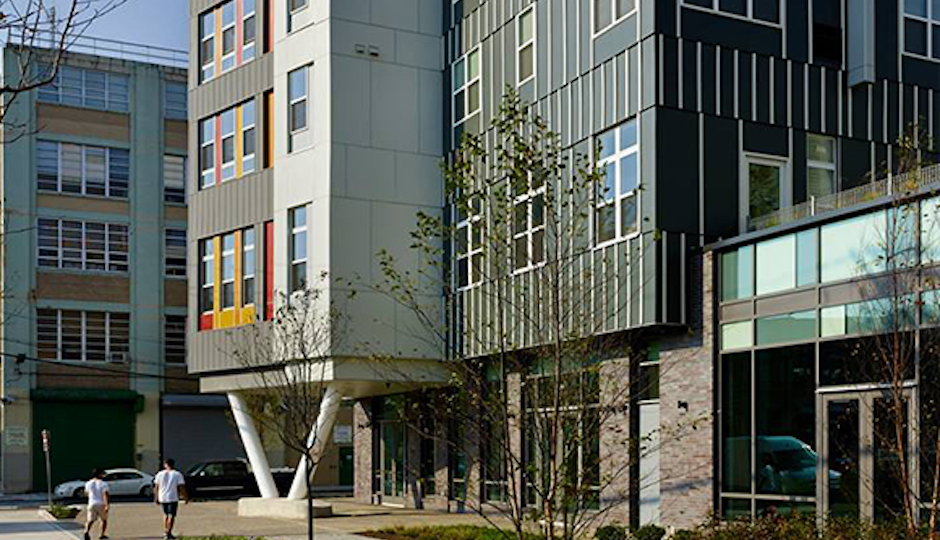Op-Ed: Why the So-Called “Affordable Housing Industrial-Complex” Is Actually a Good Thing

Paseo Verde. Low to moderate-income housing, developed by a CDC in partenrship with the city. | Image courtesy of Paseo Verde website.
(Editor’s note: This op-ed is in response to a column from a Citified insider. The author, Rick Sauer, is executive director of the Philadelphia Association of Community Development Corporations.)
Philadelphia has developed a reputation for affordability because it is so frequently compared to more expensive Northeast cities like New York and Washington, DC. But this reputation is deceptive.
In reality, Philadelphia has a deficit of nearly 70,000 affordable rental homes available to people earning 30 percent or less of the area median income, or $23,400 for a family of four, according to a recent study by the Federal Reserve Bank of Philadelphia. These households pay an average of $528 per month more than they can afford on housing costs, leaving little left over for other basic necessities.
The number of affordable and available rental units in Philadelphia for our poorest residents has dropped by 9 percentage points between 2007 and 2012, the Federal Reserve also found.
Numerous studies have borne out what those who work in housing policy have long known: low-income families who live in safe, stable affordable homes in quality neighborhoods have greater social mobility and a better shot at breaking the cycle of generational poverty.
Another way in which affordability in Philadelphia is deceptive: home prices. Low home prices certainly exist, but too often in neighborhoods that have experienced significant disinvestment and lack access to key amenities – close proximity to public transportation hubs, retail, and good quality parks – that many of us take for granted. An on-the-ground examination reveals many of the homes in these neighborhoods to be in varying states of disrepair, requiring substantial investment that even if a family could afford to make them, would give them a home with more debt than the resulting home is worth.
And this Spring, Philadelphia home prices increased the most they have in ten years. While new market-rate homes priced at $400,000 plus will help build the City’s tax base over the long-run, little “middle-market” housing is being built in Philadelphia that is priced at a level that moderate- to middle-income households such as our teachers, nurses, and mail carriers can afford.
Since many of these households earn too much to qualify for “traditional” affordable housing, they are relegated to the sidelines of housing policy. Shouldn’t a teacher or a fire fighter have an opportunity to live near their work in a quality neighborhood? And shouldn’t lower-income families also have the opportunity to build equity via a quality home in an attractive neighborhood?
That’s where City Council’s 2,000 Workforce and Affordable Housing Initiative could make a difference: by creating new affordable homes in rapidly appreciating neighborhoods like Point Breeze or Francisville. The initiative strives to achieve this by tapping one resource Philadelphia has in spades: vacant land. Our abundance of vacant land is an opportunity to provide a different form of subsidy on the construction of homes when it is given at little cost and to the long-term benefit of taxpayers.
Earlier this year, PACDC released a policy platform: “Beyond Gentrification: Toward Equitable Neighborhoods.” In it, we call on the Mayor and City Council to come up with a long-range plan to address Philadelphia’s affordable home needs.
Any forward-thinking housing plan needs to create a balance between making a more significant investment in the development of new affordable homes, the preservation of existing homes, and homelessness prevention to ensure inclusive communities for families at a range of income levels that can be sustained over time. As a city struggling to spur equitable growth, we must advance strategies that allow residents to stay in neighborhoods that are improving so they can benefit from the changes; improve our existing stock of affordable homes so they are of high quality; and allow people to choose the right neighborhood for them by creating more affordable options and mixed-income housing developments.
And while the Philadelphia Housing Trust Fund has already assisted over 25,000 families, we need to at least double its resources to $25 million per year to begin replacing funds cut by the federal and state governments to more effectively implement such a strategy.
Realizing a future that all Philadelphians deserve requires a range of interventions aimed at ensuring that every neighborhood can become a community of choice. We must ensure that as Philadelphia transforms, all of our communities are inclusive of families from a diversity of income levels.
Philadelphia’s CDCs are at the forefront of creating positive, equitable neighborhood change. Yes, CDCs are important developers of new, affordable homes. Every year they bring millions of dollars in competitive Low Income Housing Tax Credits to Philadelphia that then leverage millions more in additional private investment. Not only are these funds that would otherwise go elsewhere, but they are strategically spent to both ensure continued affordability in rapidly improving areas and to invest in weaker market neighborhoods that can spur private market investment. CDCs also work to preserve existing homes by assisting lower-income homeowners with repairs, and provide counseling to help homebuyers purchase and remain in their homes.
CDCs aren’t just limited to housing; they are a driving force of community revitalization. They improve neighborhood shopping districts to provide local access to goods, services and jobs; provide a range of social services to address resident needs; and develop community amenities like open space and health centers. Their strong return on investment of over $3.3 billion to Philadelphia over the past two decades demonstrates the key role they play in advancing equitable neighborhoods for all Philadelphians.
Rick Sauer is Executive Director of the Philadelphia Association of Community Development Corporations.